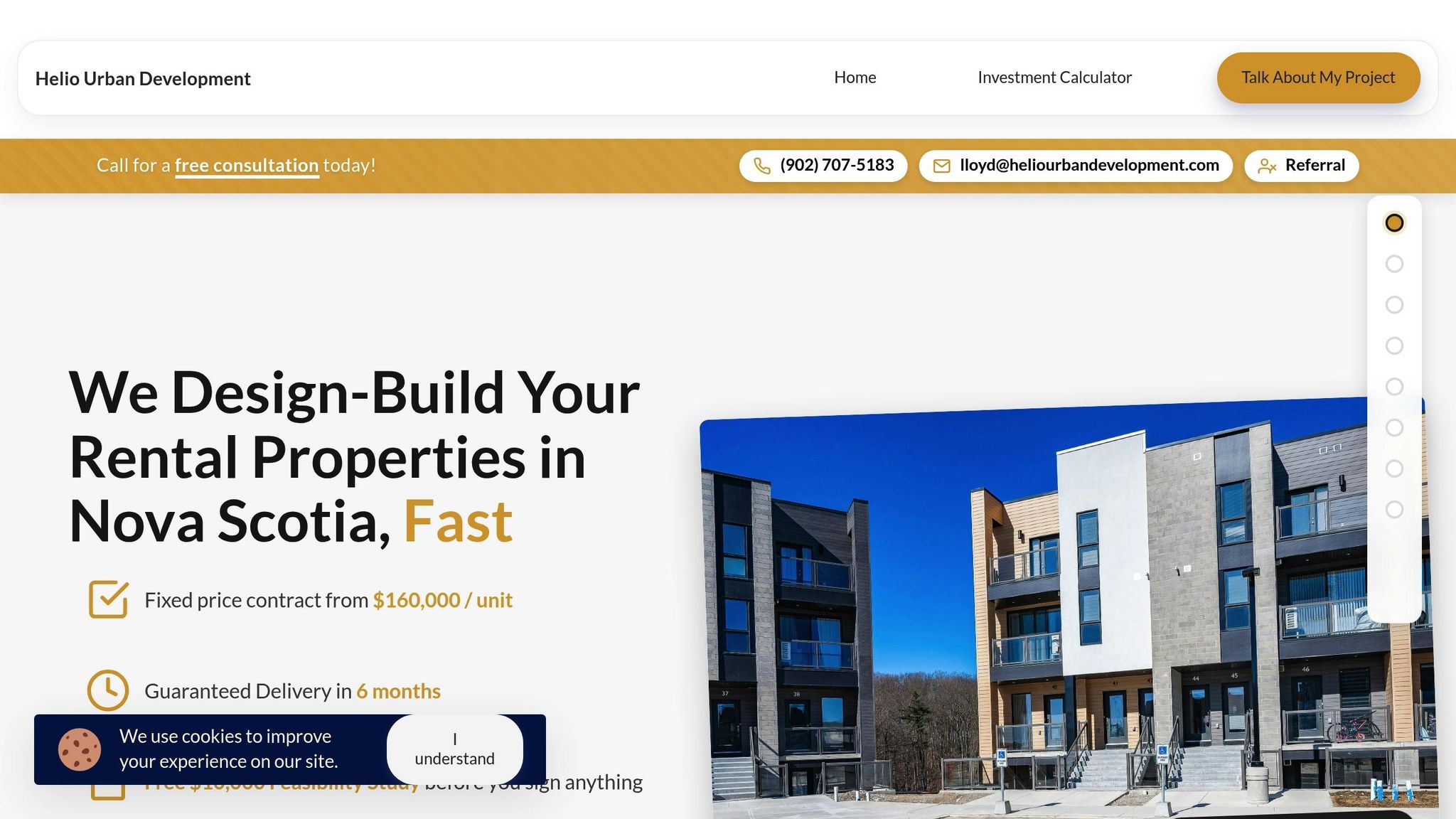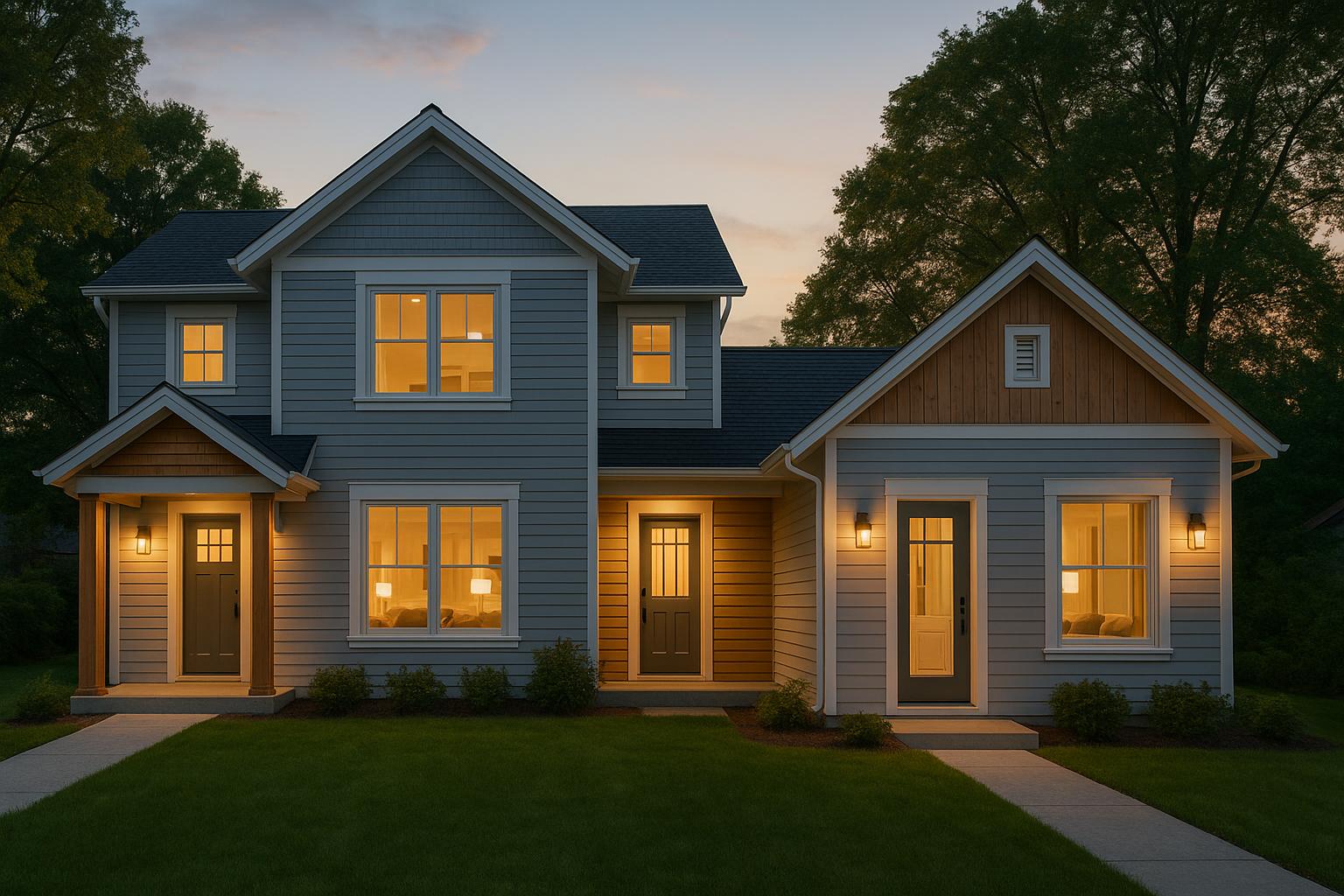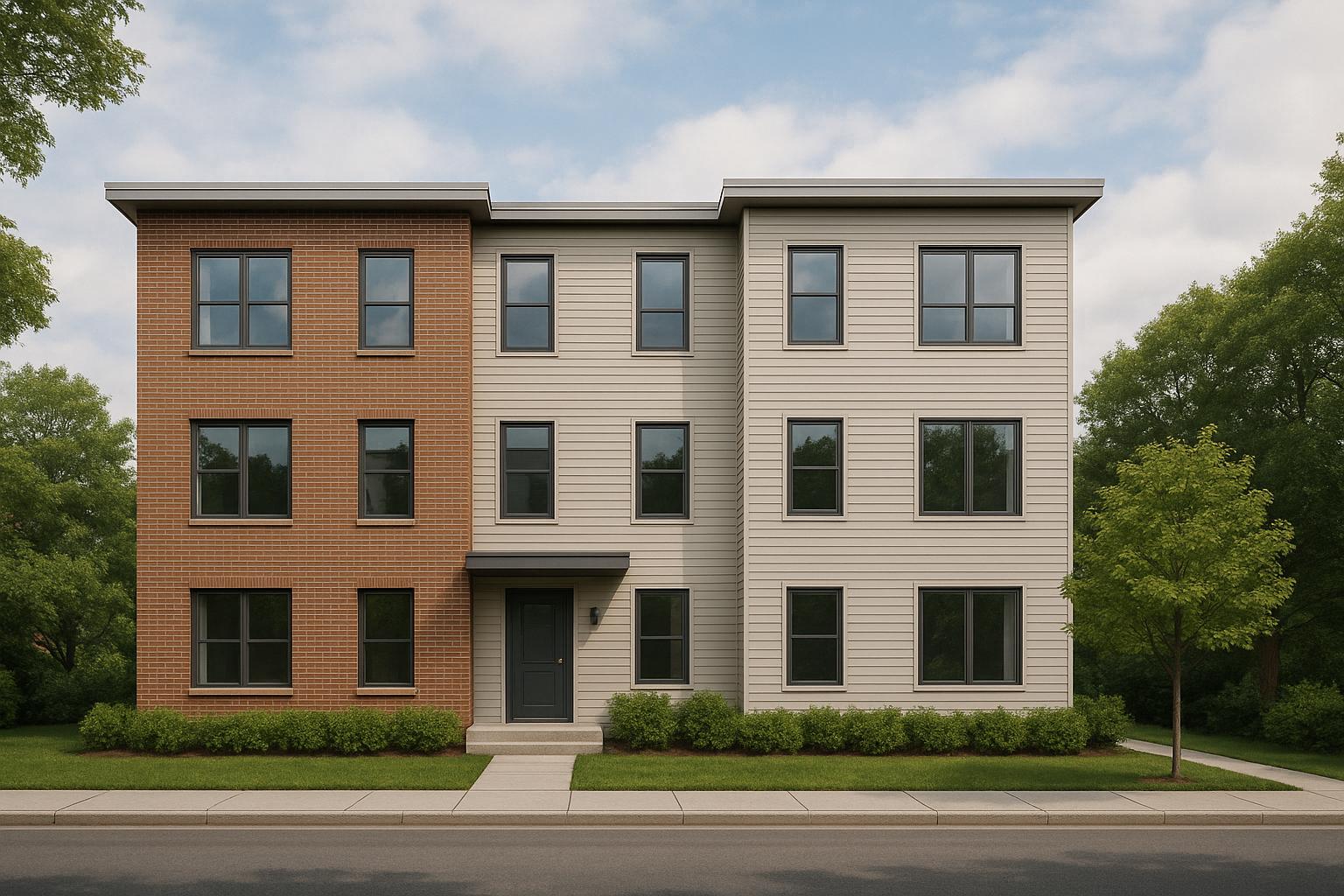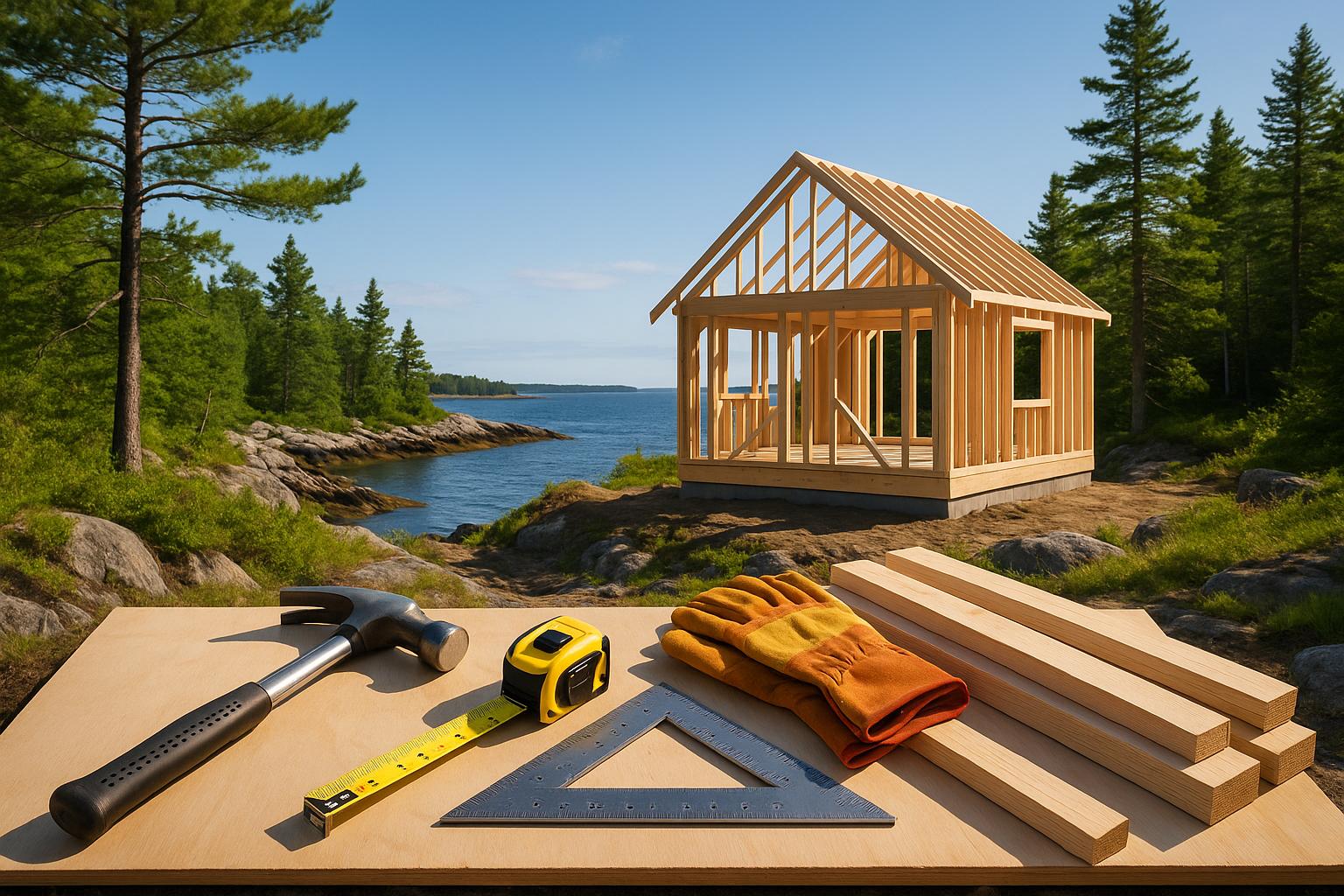ER-3 zoning in Halifax offers a chance to turn inherited properties into multi-unit rental developments. With the city facing a housing shortfall of 18,000 units and a need for 52,000 homes by 2027, this zoning allows for buildings up to 12 metres tall with up to 8 units. Key benefits include:
- Flexible Development Options: Build single-family homes, fourplexes, townhouses, or small apartment buildings.
- Rental Income Potential: Two-bedroom units can generate $1,950–$2,100 per month.
- Simplified Construction: Integrated design-build firms offer fixed-price contracts, starting at $160,000 per unit, with guaranteed timelines.
Check zoning maps, design requirements, and heritage restrictions before starting. With the right planning, you can turn your property into a reliable income source while contributing to Halifax's growing housing needs.
3306 Windsor St, Halifax, NS Presented by Assist 2 Sell, HomeWorks Realty Ltd..

Development Options Under ER-3 Zoning
ER-3 zoning provides property owners in Halifax with a variety of options for multi-unit residential development, making it particularly appealing for inherited properties. By understanding the permitted building types and design requirements, you can explore how best to use your property.
Permitted Building Types
Under ER-3 zoning, you’re allowed to construct a range of residential buildings. These include single-family homes, townhouses, and multi-unit dwellings. You can also add backyard suites and secondary suites, giving you plenty of flexibility to align your development plans with your financial objectives and the specifics of your lot[1].
Building Rules and Design Requirements
To maintain the character of the neighbourhood, ER-3 zoning comes with specific dimensional standards. For instance, the maximum allowable building height is 11 metres (36.1 feet), which accommodates multi-storey structures[1]. Lot coverage is capped at 40% for standard-sized lots but increases to 50% for lots larger than 325 square metres[1]. Additionally, side yards must be at least 1.25 metres (4.1 feet), while rear yards require a minimum depth of 6 metres (19.7 feet)[1].
| Requirement | ER-3 Zone Standards |
|---|---|
| Minimum Lot Area | 325 sq. m (3,498 sq. ft.) |
| Minimum Lot Frontage | 10.7 m (35.1 ft.) |
| Maximum Building Height | 11 m (36.1 ft.) |
| Maximum Lot Coverage | 40% (50% for lots > 325 sq. m) |
| Minimum Side Yards | 1.25 m (4.1 ft.) |
| Minimum Rear Yard | 6 m (19.7 ft.) |
Heritage Properties and Restrictions
If your property is located within a Heritage Conservation District, additional rules will apply. These areas require that any exterior changes align with the historic character of the district. This means you’ll need to carefully plan modifications to ensure they respect heritage guidelines while still meeting your development needs[1]. These extra considerations can influence what’s possible, so it’s essential to factor them into your plans early on.
Multi-Unit Development Examples
Inherited ER-3 properties open up a range of opportunities for multi-unit developments, allowing property owners to increase rental income and make the most of their lot's potential. Below, we’ll explore some common building options and how they align with various lot sizes and investment goals.
Common Multi-Unit Building Options
When it comes to ER-3 zoning, here are some popular multi-unit configurations to consider:
Fourplexes are a straightforward way to boost rental income. With four separate rental units, these buildings fit well on standard residential lots. Depending on the height restrictions, you can opt for a two- or three-storey design, making them an efficient choice for generating steady rental revenue.
Townhouses are particularly appealing for larger lots or corner properties. Thanks to ER-3 zoning, interior townhouse units only need 130 square metres of lot area, while end units require 245 square metres[1]. This flexibility allows you to maximize the number of units on your property compared to other building types.
Small apartment buildings (5+ units) offer the highest rental income potential but require larger lots and involve more complex construction. These buildings make full use of the height allowance, accommodating multiple floors and a higher number of units.
How to Check Development Feasibility
Before diving into any development project, it’s crucial to confirm that your plans align with zoning rules and design requirements. Here’s what to check:
- Zoning and Lot Size: Ensure your lot meets the minimum size requirement of 325 square metres for multi-unit dwellings and that your project fits within the ER-3 zoning guidelines[1].
- Design Requirements: The Centre Plan specifies setbacks, height restrictions, and lot coverage limits. For most standard lots, coverage is capped at 40%, although larger lots may allow for more[1].
- Building Code Compliance: Multi-unit dwellings must meet stricter standards for fire safety, accessibility, and structural integrity compared to single-family homes. These requirements can impact both costs and design options.
- Municipal Approvals: The approval process varies depending on the scope and location of your project. Contact HRM Planning & Development to confirm the steps required for your specific development[4].
Lastly, consider how your project fits within the character of the neighbourhood. ER-3 zones are typically located along major transit routes or in areas where townhomes were already permitted[1].
Comparing Project Types
Each type of multi-unit development comes with its own set of benefits and challenges. Here's a quick comparison of the key factors:
| Factor | Fourplex | Townhouse (Interior/End Units) | Small Apartment Building |
|---|---|---|---|
| Unit Count | 4 units | Typically 3–6 units | 5+ units |
| Minimum Lot Size | 325 sq. m | 130 sq. m (interior) / 245 sq. m (end) | 325+ sq. m |
| Rental Income Potential | $7,800–$8,400/month | $5,850–$12,600/month | $9,750+/month |
| Construction Complexity | Moderate | Moderate to High | High |
Fourplexes are ideal for property owners looking for a simpler development option with manageable costs. With an estimated construction cost of $160,000 per unit, a fourplex would require a total investment of approximately $640,000. Each unit could bring in $1,950–$2,100 in monthly rent, making it a reliable choice for steady income.
Townhouses are a flexible solution, especially for irregular lot shapes or when increasing the unit count is a priority. They’re a great fit for larger or corner properties.
Small apartment buildings offer the highest rental returns but come with greater complexity and higher upfront costs. These projects are best suited for those with a larger budget and the capacity to manage more intricate construction processes.
Choosing the right multi-unit development depends on your budget, risk tolerance, and long-term management plans. An integrated, fixed-price construction approach can help simplify the process and keep your project on track.
Construction Approaches for Property Owners
When it comes to making the most of your inherited ER-3 property, choosing the right construction method is crucial. The approach you take can heavily influence your budget, timeline, and overall experience. It’s a decision that lays the groundwork for fixed costs and smoother project handling.
Fragmented vs. Integrated Construction
Traditional fragmented construction involves juggling multiple contracts and coordinating with various professionals - architects, engineers, contractors, and specialized trades. This setup often leads to miscommunication, delays, and unexpected costs. The lack of alignment between design plans and specifications can further escalate these issues, creating unnecessary headaches.
On the other hand, an integrated design-build approach consolidates architects, engineers, and construction teams under a single contract. This method simplifies the process by providing one point of accountability. Property owners adopting this approach can save approximately $47,000 in coordination costs and significantly reduce project timelines, completing construction in about six months instead of the typical 12 to 18 months. This streamlined process also makes fixed-price contracts more achievable.
Fixed-Price Construction Benefits
One major perk of the integrated approach is the ability to lock in a fixed-price contract. In fragmented projects, poor coordination often leads to budget overruns of 30–60%. Fixed-price construction eliminates this uncertainty by providing a clear cost upfront, making financial planning and securing loans much easier.
Additionally, fixed-price contracts often include guarantees on project timelines. These guarantees ensure work is completed on schedule, with financial penalties applied for missed deadlines. This not only keeps the project on track but also provides peace of mind and a clear roadmap for completion.
Helio Urban Development's Approach

Helio Urban Development specializes in integrated design-build services tailored for property owners looking to develop 4+ unit rental projects on their land. Their process is designed to tackle common issues such as coordination problems, budget overruns, and delays.
"Every quote is personally reviewed and timelines are backed by financial penalties." – Lloyd Liu, Co-Founder & CEO, Helio Urban Development
Helio offers fixed-price contracts starting at $160,000 per unit, with a guaranteed six-month completion timeline and penalties of up to $1,000 per day for delays. Their all-inclusive service covers architectural plans, engineering, permits, construction, project management, and quality assurance. Plus, property owners receive daily updates with photos, ensuring transparency throughout the project.
Currently managing multiple projects across Nova Scotia, Helio has developments planned for early 2026. They also provide a free $10,000 feasibility study to help property owners understand what can be built on their land and the potential returns. Additionally, their work comes with a two-year warranty.
For those looking to maximize financing options, Helio offers a CMHC MLI Select plan at $200,000 per unit. This option qualifies for 95% financing with a 50-year amortization period, allowing property owners to build more units while maintaining positive cash flow from day one [6].
sbb-itb-16b8a48
Zoning and Approval Process
Getting a handle on zoning rules is essential if you want to make the most of the development potential of your inherited ER-3 property. To navigate Halifax's zoning regulations effectively, use the city's official mapping tool and reach out to the relevant municipal departments to identify any special requirements for your property.
How to Navigate ER-3 Zoning Rules
The first step in developing your ER-3 property is figuring out exactly what you’re allowed to do with it. Halifax offers an ExploreHRM interactive mapping tool that makes this easier. By entering your address, street, or community name, you can quickly identify your property’s zoning designation and any other restrictions that might apply.
For detailed information on permitted developments, consult the official guidelines [1]. Keep in mind that factors like lot size, setback rules, or heritage restrictions could also come into play.
For a deeper dive into what’s allowed, refer to the Centre Plan and Land Use By-law, which governs development in the Regional Centre, including Peninsula Halifax and Dartmouth within the Circumferential Highway. Over time, the Centre Plan will replace four separate planning documents for the area [4]. If you have specific questions, you can contact HRM Planning & Development at planhrm@halifax.ca. Their staff can clarify ER-3 zoning rules and help guide you through the application process [4]. These steps are especially important if your property has heritage-related requirements.
Heritage Property Requirements
If your ER-3 property is designated as heritage or is located in a Heritage Conservation District, additional reviews will be required. These reviews can influence your project’s timeline and the design choices available to you.
For significant exterior changes to a heritage property, you’ll need approval from the Heritage Advisory Committee and Regional Council [8]. This process can add time to your project and may limit some design options.
"The purpose of the Heritage Property Program is to conserve significant heritage resources including buildings, streetscapes, sites, areas, and districts that reflect the rich heritage throughout the municipality."
- Heritage Property Program, Halifax [7]
That said, a heritage designation doesn’t mean development is off the table. The municipality offers flexibility when it comes to adapting and rehabilitating heritage properties. Owners of registered heritage properties can even apply for development agreements to propose uses or structures that wouldn’t normally be allowed under zoning rules [8]. Additionally, heritage staff provide free advice and on-site consultations to help property owners explore their options [8].
Municipal Resources and Contacts
Once you’ve got a clear understanding of the zoning and heritage rules, you can tap into municipal resources to help streamline your application process. Halifax offers several tools and contacts to assist property owners:
- For zoning and application questions, reach out to HRM Planning & Development at planhrm@halifax.ca.
- For properties in Heritage Conservation Districts, consult with heritage staff for guidance.
- The municipal website is another valuable resource, providing zoning details, application forms, and guides that explain ER-3 requirements and heritage district guidelines step by step.
If your property falls within a Community Plan Area outside the Centre Plan’s boundaries, different land use by-laws and policies may apply. Planning staff can clarify which regulations are relevant and guide you through the appropriate approval process.
Taking the time to understand these municipal resources before diving into development planning can save you from unnecessary delays. With accurate information and complete applications, you’ll be better positioned to keep your project on track.
Conclusion: Development Opportunities for Inherited Halifax Properties
Halifax's ER-3 zoning transforms single-family lots into multi-unit developments, creating a chance for property owners to tap into the growing demand for rental housing. With the city facing a shortfall of nearly 18,000 units and needing an additional 52,000 homes by 2027 [3], owning ER-3-zoned land puts you in a strong position to meet this need while building long-term financial security.
This zoning allows for buildings up to 12 metres tall with up to eight units per lot [5], and lot coverage ranging from 50% to 60%, depending on the property size. For inherited properties, this means the potential to house multiple families instead of just one - significantly boosting both rental income and property value.
Halifax is also making it easier to develop. The city’s $79 million investment over three years is aimed at speeding up planning and project approvals [3]. Additionally, Halifax has identified "missing middle housing" - medium-sized developments between single-family homes and high-rises - as a critical solution to the housing crisis [3]. For property owners, these factors create a favourable environment for development.
Key Points for Property Owners
- ER-3 zoning supports diverse development options: From multi-unit residential buildings to mixed-use developments with commercial spaces on the ground floor, this zoning offers flexibility for various projects [1][2].
- Early planning avoids costly missteps: Assess your lot size, understand setback rules, and confirm parking requirements to ensure your project meets zoning regulations.
- Integrated design-build firms simplify construction: These companies streamline the process, offering fixed-price construction at $160,000 per unit with guaranteed timelines, reducing the stress of managing multiple contractors.
Halifax's rental market also makes these developments financially appealing. Well-constructed two-bedroom units can fetch $1,950 to $2,100 per month, providing annual returns of 12% to 20%. Plus, with CMHC MLI Select financing, eligible projects can secure 95% financing with a 50-year amortization period, making development more affordable.
Inheriting an ER-3-zoned property in Halifax presents a unique opportunity. The demand for housing is high, the zoning is already in place, and municipal support is growing. With the right planning and reliable construction partners, you can turn your property into a valuable income-generating asset while contributing to the city’s housing needs.
FAQs
What financial advantages can I gain by developing an inherited ER-3 zoned property in Halifax?
Developing an inherited ER-3 zoned property in Halifax offers a chance to tap into strong financial potential. ER-3 zoning allows for the construction of up to eight units per lot, creating an opportunity to boost rental income and raise the overall value of the property. This zoning is specifically intended to support multi-unit residential projects, making it an attractive option for those eager to see higher returns.
Beyond the potential for increased rental revenue, the process is made even more appealing by streamlined approval systems and the option to use cost-effective construction techniques. These advantages can help keep expenses in check and move projects along faster. Plus, with financing options tailored for multi-unit developments readily available, ER-3 properties in Halifax stand out as a smart choice for property owners looking to make the most of their investment.
How does a design-build approach make multi-unit property development easier?
The design-build method streamlines the development of multi-unit properties by bundling design and construction into one contract. This approach removes the hassle of juggling multiple contractors, simplifies communication, and helps avoid delays or unforeseen expenses.
With designers and builders working together from the outset, decisions can be made faster, potential challenges are spotted early, and cost estimates become more precise. For property owners, this translates to a process that's easier to manage, more predictable, and far less stressful.
How can I ensure my ER-3 zoned property in Halifax complies with heritage restrictions during development?
Navigating Heritage Restrictions for ER-3 Zoned Properties in Halifax
If you own an ER-3 zoned property in Halifax, ensuring compliance with heritage restrictions is a crucial step before making any changes or developments. The first thing to check is whether your property is designated as a municipal or provincial heritage site. Each designation comes with its own set of rules and approval processes, so understanding where your property falls is essential.
Take time to review the Heritage Property Program and the Heritage Conservation District regulations. These guidelines outline what types of alterations or developments are allowed while maintaining the historical integrity of the property.
If your property meets the criteria, you might want to apply for a Heritage Development Agreement. This allows for adaptive reuse of the property while ensuring its historical character remains intact. To make the process smoother, consider engaging with Halifax’s heritage advisory committee early on. Their insights can help you identify potential restrictions and confirm your project is in line with all requirements.
By taking these steps ahead of time, you can avoid unnecessary delays, legal complications, or unexpected hurdles during your development process.



